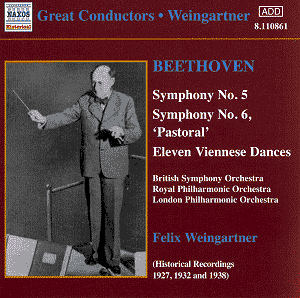My review of the Klemperer "Pastoral"
(EMI Classics 5 67965 2) was in fact a comparative review of five
"Pastorals", including this one by Felix Weingartner.
I should like, therefore, to refer readers to it and limit myself
here to quoting my conclusion that it is "one of the freshest
and most vivacious accounts ever put on disc", "sounding
remarkably well in Mark Obert-Thornís transfer".
This 1927 "Pastoral" was Weingartnerís
only recording of the 6th (an earlier attempt, with
the LSO in 1924, was not completed). He recorded the 5th,
on the other hand, four times: 1924 (LSO), 1927 (RPO), 1932 (British
SO) and 1933 (LPO). The latter was for many years the "canonical"
one since, as Obert-Thorn explains, the 1932 recording was dimly
recorded and issued only in the USA, necessitating the remake
of a year later. Now that modern transfer techniques enable us
to hear the 1932 version in sound to match anything of its day,
there has been a tendency to rate it as the finest performance
of the four.
The "British Symphony Orchestra" was
a pick-up band of war veterans, but they were clearly musicians
of high quality. Considering that the "deputy" system
was still in use in some of the London orchestras of the day,
one wonders just how many players it really had in common with,
say, the LSO. I encountered it again not long ago in the Naxos
transfer of the Szigeti 1932 recording of the Beethoven Violin
Concerto, this time with Bruno Walter conducting. In any case
the playing shares many of the qualities I commented on in the
1927 "Pastoral"; clean attack, precious little portamento
in the strings and clear textures. Evidently Weingartner based
his conception of the music on these particular orchestral qualities
and had the ability to obtain them from whatever orchestra he
had in front of him.
Whereas in the "Pastoral" he adopted
very swift tempi, often in excess of Beethovenís metronome markings,
you will not hear anything especially unusual here. He does, importantly,
make sure that the right relationship is observed between the
Scherzo and the Finale, for which Beethoven has indicated a broader
tempo. Many conductors reverse this, producing a Finale of superficial
fire and fury; others respect the relationship at the beginning
but let the war-horse run away with them after about a dozen bars
(Klempererís solution was to adopt the same tempo for both movements).
Weingartner sees that a Scherzo which rises from the suppressed
fire of the beginning to a trio of scalding energy then gives
way to a grandly majestic (but not heavy) Finale.
By todayís standards Weingartner is fairly flexible
in the first two movements. He does not make the so-called "fate"
motive as portentous as Furtwängler but he does allow the
pace to slacken a little more each time it appears. He also relaxes
the tempo in the lyrical passages, picking up in the hammering
8th-note passages which are extremely dramatic. By
the same token in the "Andante con moto" he allows the
march-like moments to move ahead Ė not that the gentler melodies
are in any way indulged. We have perhaps been conditioned by the
single-mindedness of Toscanini and Erich Kleiber in this work,
which was for long seen as the way to do it. With the rehabilitation
of Furtwänglerís more romantic approach maybe Weingartner
will become again for us, as for his contemporaries, the golden
mean.
At times Weingartnerís Beethoven, like Schnabelís
sonata recordings, risks sounding less remarkable to us than it
ought. This is because Weingartner and Schnabel taught more than
one generation what Beethoven should sound like; it was not ever
thus. I seem to remember a set of acoustic 78s of the 5th
under Sir Landon Ronald which a friend found in a jumble sale
and which sounded quite different. I should be curious to hear
it again. By and large the concept we have of a "Beethovenian
sound" remains that of Weingartner even to this day; only
the original instrument bands have seriously challenged it. The
"normality" of his Beethoven is in fact a measure of
its achievement. With alert and if not always immaculate performances
of the 11 Viennese Dances to show that the conductor could equally
relish the lighter side of Beethoven, this instalment of the first
complete recorded cycle of Beethoven Symphonies is no mere historical
document; it still has life and illumination to match the best
of its successors.
Christopher Howell
see also
review by Jonathan Woolf
